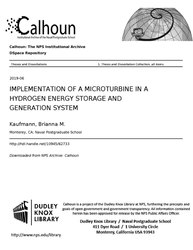File:IMPLEMENTATION OF A MICROTURBINE IN A HYDROGEN ENERGY STORAGE AND GENERATION SYSTEM (IA implementationof1094562733).pdf

Original file (1,275 × 1,650 pixels, file size: 3.55 MB, MIME type: application/pdf, 104 pages)
Captions
Captions
Summary[edit]
| IMPLEMENTATION OF A MICROTURBINE IN A HYDROGEN ENERGY STORAGE AND GENERATION SYSTEM
( |
||
|---|---|---|
| Author |
Kaufmann, Brianna M. |
|
| Title |
IMPLEMENTATION OF A MICROTURBINE IN A HYDROGEN ENERGY STORAGE AND GENERATION SYSTEM |
|
| Publisher |
Monterey, CA; Naval Postgraduate School |
|
| Description |
The energy needs of the Navy and the Department of Defense demand renewability, reliability, and resilience. Diverse means of energy production, including hydrogen gas combustion, support these requirements. The overarching goal of this research is to develop a system that produces and stores hydrogen and then combusts the hydrogen in a commercial microturbine to produce electricity. This thesis focuses on fueling a Capstone C30 MicroTurbine with hydrogen. Future research will produce a complete system that uses renewable resources, reliably produces electricity to meet demand, and demonstrates fuel resiliency. The implementation of the C30 enables the use of a renewable resource in a reliable and resilient system. A system component with the capability to produce energy from hydrogen (in addition to methane and propane) indicates resilience in fuel choices. If the primary fuel is unavailable, secondary fuels fulfill the demand for energy. Resilient technologies must use several fuels with varying properties. Computational fluid dynamic models establish expected operating differences between different types of fuel. Data collected from the C30 establish operating differences between light hydrocarbon fuels (natural gas, propane) and hydrogen gas. Benefits and challenges of using hydrogen gas-fueled microturbines and recommended improvements are discussed. Subjects: energy; resilience; reliability; renewable; hydrogen; gas turbine; microturbine; energy resilience; renewable energy |
|
| Language | English | |
| Publication date | June 2019 | |
| Current location |
IA Collections: navalpostgraduateschoollibrary; fedlink |
|
| Accession number |
implementationof1094562733 |
|
| Source | ||
| Permission (Reusing this file) |
This publication is a work of the U.S. Government as defined in Title 17, United States Code, Section 101. Copyright protection is not available for this work in the United States. | |
Licensing[edit]
| Public domainPublic domainfalsefalse |
This work is in the public domain in the United States because it is a work prepared by an officer or employee of the United States Government as part of that person’s official duties under the terms of Title 17, Chapter 1, Section 105 of the US Code.
Note: This only applies to original works of the Federal Government and not to the work of any individual U.S. state, territory, commonwealth, county, municipality, or any other subdivision. This template also does not apply to postage stamp designs published by the United States Postal Service since 1978. (See § 313.6(C)(1) of Compendium of U.S. Copyright Office Practices). It also does not apply to certain US coins; see The US Mint Terms of Use.
|
 | |
| This file has been identified as being free of known restrictions under copyright law, including all related and neighboring rights. | ||
https://creativecommons.org/publicdomain/mark/1.0/PDMCreative Commons Public Domain Mark 1.0falsefalse
File history
Click on a date/time to view the file as it appeared at that time.
| Date/Time | Thumbnail | Dimensions | User | Comment | |
|---|---|---|---|---|---|
| current | 23:15, 21 July 2020 |  | 1,275 × 1,650, 104 pages (3.55 MB) | Fæ (talk | contribs) | FEDLINK - United States Federal Collection implementationof1094562733 (User talk:Fæ/IA books#Fork8) (batch 1993-2020 #18369) |
You cannot overwrite this file.
File usage on Commons
The following page uses this file:
Metadata
This file contains additional information such as Exif metadata which may have been added by the digital camera, scanner, or software program used to create or digitize it. If the file has been modified from its original state, some details such as the timestamp may not fully reflect those of the original file. The timestamp is only as accurate as the clock in the camera, and it may be completely wrong.
| Short title | IMPLEMENTATION OF A MICROTURBINE IN A HYDROGEN ENERGY STORAGE AND GENERATION SYSTEM |
|---|---|
| Image title | |
| Author | Kaufmann, Brianna M. |
| Software used | Kaufmann, Brianna M. |
| Conversion program | Adobe PDF Library 15.0 |
| Encrypted | no |
| Page size | 612 x 792 pts (letter) |
| Version of PDF format | 1.4 |

